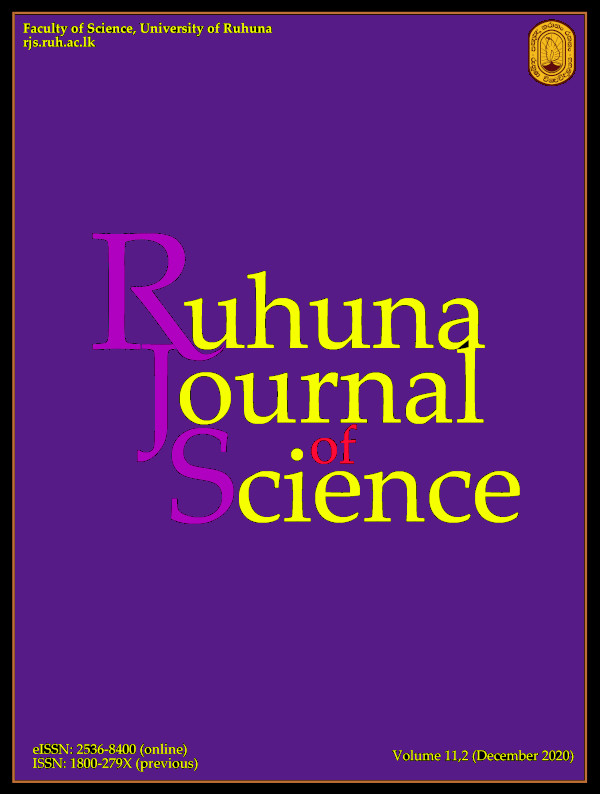Ethnobotanical study of Buru Community Forest, Taraba State, Nigeria
Abstract
An ethnobotanical study of Buru Community Forest was conducted using Participatory Rural Appraisal techniques. A total of 91 species of plants belonging to 43 Families with high endemicity were recorded. The dominant families were Fabaceae, Euphorbiaceae, and Meliaceae. Many species such as Tetrapleura tetrapetra, Phyllanthus mullerianus, Sarcocephalus latifolius and Aframomum melegueta had multiple uses. The three major uses of the species are for medicinal (39 species), edible (33 species) and construction purposes (30 species). Keywords: Buru community forest, Ethnobotanical, Participatory Rural Appraisal technique.References
Akinsoji A. 2003. Vegetation studies of Gashaka Gumti National Park, Nigeria 1: Ethnobotany. The Nigerian Field 68:124-144
Akinsoji A. 2013. Community-Based Forest Management in Buru, Taraba State, Nigeria. Journal of Environment and Earth Science 3(12): 146-151
Akinsoji A. 2017. Market survey of Spices and vegetables obtained from four markets in Lagos metropolis. FUW Trends in Science and Technology 2(2): 788-791
Anbarashan M, Padmavathy A. 2010. Ethno-medicinal plants of five sacred groves in Andalore District, Tamilnadu, India. Ethnobotanical Leaflets 14: 774-780
Bawden MG, Tuley P. 1969. The land resources of S. Sardauna and S. Adamawa Provinces, Northern Nigeria. Land Resources Division, Tolworth, Surrey.
Chapman JD, Chapman HM. 2001. The forests of Taraba and Adamawa States, Nigeria. An ecological account and plant species checklist. University of Canterbury, Christchurch, New Zealand.
Ezealor AU. 2002. Critical sites for Biodiversity Conservation in Nigeria. Nigerian Conservation Foundation, Lagos. 110pp.
Gbile ZO. 1980. Vernacular names of Nigerian plants (Hausa). Federal Department of Forestry, Lagos. 63pp.
Martin GJ. 1995. Ethnobotany. Chapman and Hall, London. 268pp
McCracken JA, Preety JN, Conway GR. 1998. An Introduction to rapid rural appraisal for agricultural development. Internationl Institute for Environment and Development, London.
Myers N, Mittermeier CG, de Fonseca GAB, Kent J. 2002. Biodiversity hotspots for priorities. Nature 403: 1045
Noss R. 2016. Announcing the World’s 36th Biodiversity Hotspot: The North American Coastal Plain. Retrieved on 08/16/2020, https://www.cepf.net/stories/announcing-worlds-36th-biodiversity-hotspot-north-american-coastal-plain
Obot EA, Inahoro I. 2004. Natural Resources Management Plan for Buru community forest. Nigerian Conservation Foundation, Lagos. 58pp.
Phannel AS, Nyunja RO, Onyago JC. 2010. Plant species in the folk medicine of Kit Mikayi region, Western Kenya. Ethnobotanical Leaflets 10: 836-840
Walter S. 1998. The utilization of non-timber forest products in the rainforest of Madagascar. A case study. Plants Research and Development 48: 121-144
Downloads
Published
Issue
Section
License
From Volume 7 (2016) onwards, all articles published in Ruhuna Journal of Science are Open Access articles published under the Creative Commons CC BY-NC 4.0 International License. This License permits use, distribution and reproduction in any medium, provided the original work is properly cited and is not used for commercial purposes.
Copyright on any research article published in RJS is retained by the respective author(s).
Authors who publish with this journal agree to the following terms:
a) Authors retain copyright and grant the journal right of first publication with the work simultaneously licensed under a Creative Commons Attribution License CC-BY-NC 4.0 International, that allows others to share the work with an acknowledgement of the work's authorship and initial publication in this journal.
b) Authors are able to enter into separate, additional contractual arrangements for the non-exclusive distribution of the journal's published version of the work (e.g., post it to an institutional repository or publish it in a book), with an acknowledgement of its initial publication in this journal.
c) Authors are permitted and encouraged to post their work online (e.g., in institutional repositories or on their website) prior to and during the submission process, as it can lead to productive exchanges, as well as earlier and greater citation of published work (See The Effect of Open Access).

